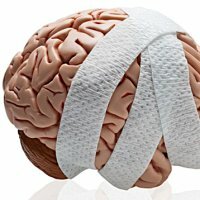Contusion of the brain

Brain injury is considered a serious traumatic injury, resulting in the appearance of characteristic focal brain activity disorders. With a brain contusion, the first symptom is loss of consciousness. It all depends on how severe a trauma - a person can lose consciousness for a few minutes or for a longer time.
The consequences of an injury can be unpredictable complications. Perhaps the following development - frustration of the circulatory form, increased pressure of the spinal cord fluid, rapid brain edema, etc.
The condition of severity in such cases is determined by specialists in the hospital, by examining the relevant analyzes. Depending on the type of injury and the general clinic of the disease depends on the prognosis for recovery of the patient.
What are the types of bruises?
There is a classification of brain contusions in terms of severity:
Degree light - about 15% of the number of victims of such trauma is diagnosed. As a result of a minor injury, a person can lose consciousness for a short period of time - several minutes or hours. The following symptoms are observed: retrograde, anterograde, and congasic amnesia. It is possible and the occurrence of vomiting. There are cases when the respiratory and heart rhythm is broken, blood pressure also rises.
In many cases, the symptoms of neurological symptoms are poorly expressed and take place about two weeks later, as a result, the health of the victim is restored.
Brain contusions in mild cases in children occur very often, as they often fall, while striking the head.
Degree average - 10% of the number of victims apply for diagnosis. After an injury of moderate severity, the victim may not leave the unconscious state until 7 o'clock. Violation of vital functions in this case is insignificant - fever, visual impairment, etc. Most bruises accompany subarachnoid hemorrhage, as well as a fracture of the base and cranial vault.
Degree severe - approximately 7% of the number of victims are diagnosed. For a severe degree, a prolonged coma is characteristic. This state is accompanied by asymmetric or symmetric decerebriation;Disabling the functions of the brain. Also violated are the frequency and rhythm of breathing, heart activity, hyperhidrosis, fever, etc.
Symptoms of
Symptoms that are observed with a contusion of the brain and depend on the degree of severity.
- is an unconscious condition;
- retrograde amnesia;
- dizziness and headache;
- movement coordination disorder;
- vomiting, nausea;
- deformed consciousness;
- vision impairment - double vision, temporary blindness, phobia of light;
- dilated pupils;
- speech impairment;
- hearing impairment;
- disturbance of the swallowing reflex;
- slowed heart rate;
- changed breathing - rare and weak;
- increased blood pressure;
- loss of sensitivity in some parts of the body;
- uncontrolled function of defecation and urination;
- bleeding from the nose and ears;
- paralysis;
- coma.
Treatment
Methods of treatment are divided into surgical and therapeutic.
Therapeutic methods of treatment include the pharmacological elimination of intramuscular hypertension. In addition, preventive measures are taken to prevent possible cerebral edema.
Neurosurgical treatment is dictated by the urgency of eliminating physical factors that result in the squeezing of the brain tissue. Hematomas, hemorrhages, which can not be eliminated with medicines, have to be surgically removed - bone-plastic trepanation.


